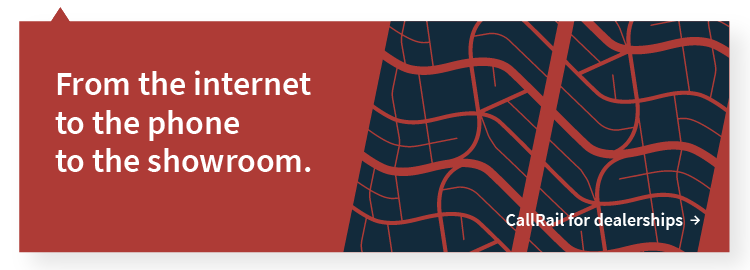When it comes to business engagement and customer interactions, phone calls are still king. According to Google, 70 percent of mobile users use click-to-call buttons to connect with businesses directly from the search engines results page. In the same report, Google also found that 61 percent of mobile searchers consider click-to-call to be the most important feature of the online-shopping process.
Contrary to popular belief, customers still want to speak with companies over the phone, and the interactions they’re having over the phone is spurring them to move through the sales funnel. This is especially true when it comes to the importance phone calls have for auto dealerships: A 2016 Autotrader Car Buyer study reports that phone calls are the second-most-common initial point of contact with dealers.
While social media and paid ads may drive visits to your website, phone calls have a high likelihood of getting customers into your showroom. It’s essential for call tracking to be part of your dealership marketing strategy — this technology will reveal which PPC ads, pages, keywords, and marketing campaigns are influencing customers to call your business and move further down the sales funnel.
A report commissioned by Forrester Consulting found that those who place an inbound phone call convert to a paying customer 30 percent faster than those who did not make a phone call. Forrester also reports that customers who make a call spend 28 percent more than those who do not.
In other words, phone calls strengthen customer and business relationships, which result in both higher conversions and greater overall revenue.
How to incorporate call tracking into dealership marketing
You might be overwhelmed by the thought of adopting another analytics tool, but it’s less complicated than you might think. Here are some simple-yet-effective ways that call tracking can complement your dealership marketing strategy:
- Call tracking numbers: To better understand how customers are finding your business, you can use unique tracking numbers to clearly identify online and offline channels that are generating inbound calls. Whether it’s Google Ads, a billboard, Bing, a radio ad, or a social media profile page, call tracking numbers help you understand which sources work best to help customers find your business, so you can optimize the channels that are best at bringing in qualified calls.For online sources, Dynamic Number Insertion displays unique call tracking numbers to website visitors, while also ensuring that users will continue to see their specific tracking number every time they visit your site.
- Track the efficiency of your keywords: Are certain search engine keywords attracting customers? And if so, are they giving your business a call? Keyword-Level Call Tracking reveals both the keywords a site visitor searched for and the pages they visited on your site. CallRail’s Conversation Intelligence suite includes additional features like Keyword Spotting and Call Highlights to dive deeper into conversation analytics and enhance keyword bidding strategies.Assigning unique tracking numbers to various traffic sources allows you to see which of your marketing efforts are most effective in driving customers to call your business.
Using call tracking as a lead generation tool
Ultimately, the aim of driving more inbound phone calls is to turn them into showroom visits, which then result in sales. A phone call from a prospect signifies interest in your dealership, and these calls also tend to have a higher probability of leading to a conversion.
Click-to-call ads are a reliable and effective way of encouraging consumers to engage with your business, which makes call tracking essential if your marketing strategy involves driving inbound calls via display ads. As Google reported, 39 percent of customers frequently use click-to-call buttons on display ads to call a business directly from mobile search results. Additionally, 51 percent of customers use click-to-call to schedule an appointment or make a reservation.
Making full use of call tracking technology helps you discover who is searching for your business, and monitor the potential customers who are opting to call your business directly from an online listing. In turn, this enables you to optimize your mobile marketing and SEO strategies around the highest-performing channels and ad variants.
CallRail helps dealerships make the most of their marketing
For a real-world example of how call tracking can make a big difference in your dealership’s bottom line, look to Humberview Group, a franchise based in Toronto, Ontario, that represents more than 30 auto dealerships in the greater Toronto area. By making full use of CallRail’s Keyword Tracking and Dynamic Number Insertion features, Humberview was able to triple their inbound lead generation.
It’s further proof that call tracking is an effective way to leverage a traditional marketing channel to gain valuable insights into your dealership marketing strategies.
The post A guide to using call tracking to optimize dealership marketing appeared first on CallRail.

